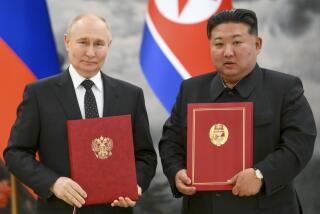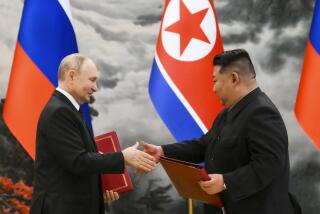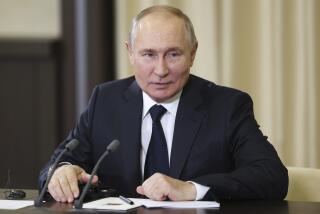Russia, China Finalize $3.5-Billion Nuclear Deal
MOSCOW â Russia and China made final Monday a deal worth up to $3.5 billion in a joint venture to build a nuclear plant near Shanghai as part of Beijingâs plans to meet its fast-expanding power needs by constructing 100 reactors in the next 50 years.
The two 1,000-megawatt units of the Russian-built plant at Lianyungang, a coastal city about 250 miles north of Shanghai, are to begin operating in 2004 and 2005, the official New China News Agency reported.
The contract was Russiaâs biggest with a foreign country in 1997, said a jubilant Russian First Deputy Prime Minister Boris Y. Nemtsov, the onetime physicist who made a name for himself as a regional governor in part by battling Moscow over construction of a nuclear plant.
âThe Chinese side has attached great importance to it,â Chinese Premier Li Peng was quoted as saying of Mondayâs deal.
Li, who talked with the visiting Nemtsov just before the Beijing signing ceremony, said the contract was the âfine resultâ of five years of earnest preparation.
China is the worldâs fastest-growing nuclear power market. It is expected to spend between $50 billion and $60 billion between now and 2015 to meet its expanding energy needs, fostered by the growth of industry and consumer use of electrical equipment by its 1.2 billion people.
But the same fears over safety that have left the Western nuclear industry stagnating are also throwing up obstacles to Asian nationsâ desire to go nuclear.
The specter of the 1986 disaster at the Soviet-built Chernobyl power station, as well as the huge legacy of dire environmental pollution in Russia from other nuclear installations, also lingers on in the boardrooms of international financial institutions.
Although Russian officials said the Chinese project is for âlight-waterâ reactors, far safer than Chernobyl-style graphite units, the World Bank shuns financing such facilities because it considers nuclear plants too expensive and unsafe for developing nations.
So money to pay for the big power programs of Asian nations--for building capital-intensive nuclear plants that take up to a decade to complete--is increasingly being sought from energy companies themselves.
Chinese government officials said Russia would supply $1.8 billion in financing for the site at Lianyungang. Russian officials have said in the past that they expected to provide most of the financing for the project.
Among countries competing for a stake in Chinaâs lucrative nuclear energy market, the United States has so far lagged behind France, Britain, Canada and now Russia as American exports of nuclear technology to China were until recently banned.
But the ban was lifted in the fall, after the White House said it could certify that China was not supplying nuclear weapons technology to third countries such as Iran and Pakistan.
The U.S. is now expected to become a strong competitor.
But Russian Atomic Energy Minister Viktor N. Mikhailov said Moscow had already squeezed out the American competition.
âIt will be difficult for American firms on the Chinese market. They will be unable to compete with the Russian nuclear energy business,â Mikhailov told Itar-Tass news service during a November visit to Beijing. âSo Americans lost to Western Europe and Russia after all.â
Lianyungang is the sixth nuclear power plant approved for construction in China and the fourth to be built with overseas assistance. The Daya Bay facility, built by a British-French consortium, went into operation in the southern province of Guangdong in 1994. The same consortium is building another station nearby at Lingao, whose twin reactors are due to come into service by 2003. Qinshan III, a Sino-Canadian project in the eastern province of Zhejiang, is also due to come on line in 2003.
More to Read
Sign up for Essential California
The most important California stories and recommendations in your inbox every morning.
You may occasionally receive promotional content from the Los Angeles Times.










